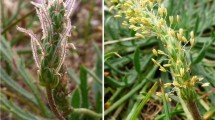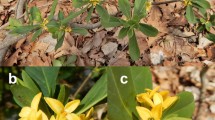Abstract
Silene acaulis (Caryophyllaceae) is an alpine-arctic plant with a gynodioecious breeding system, but significant variation in sex expression has been reported. In addition, population sex ratio may be modified by the anther-smutMicrobotryum violaceum (Pers.)Deml & Oberwinkler, which sterilizes individuals of both sexes. A survey was undertaken at several sites on Baffin Island, Canada, to determine sex ratio and assess variation in female function among morphologically hermaphroditic individuals. The degree of anthersmut infection was also measured. Six sites had high female frequencies ranging from 72–80% and < 2% smut infection. High female frequencies may indicate cytoplasmic control of male-sterility. A seventh site from a mesic habitat had only 50% females and a higher rate of smut infection (22%). Of the three sites studied in detail, 84% of females set at least one capsule compared to only 25% of the hermaphrodites, indicating reduced female function. Hermaphrodites displayed significant variability in female function. Flowers with short styles (< 4.0mm) had degenerated ovules, and field estimates confirmed that only 5% of these individuals set capsules, but comprised the majority (> 55%) of hermaphrodites. Although hermaphrodites with short-styled flowers functioned solely as males, there was no increase in pollen production compared to long-styled hermaphrodites. Long-styled hermaphrodites produced the same number of ovules as females, and all set at least one capsule but these plants were uncommon (< 11%) at all sites.
Similar content being viewed by others
References
Agren, J., Willson, M. F., 1991: Gender variation and sexual differences in reproductive characters and seed production in gynodioeciousGeranium maculatum. — Amer. J. Bot.78: 470–480.
Alexander, H. M., 1987: Pollinator limitation in a population ofSilene alba infected by the anther-smut fungus,Ustilago violacea. — J. Ecology75: 771–780.
—, 1989: An experimental field study of anther-smut disease ofSilene alba caused byUstilago violacea: genotypic variation and disease incidence. — Evolution43: 835–847.
—, 1988: Disease spread and population dynamics of anther-smut infection ofSilene alba caused by the fungusUstilago violacea. — J. Ecology76: 91–104.
Alexander, M. P., 1969: Differential staining of aborted and nonaborted pollen. — Stain Technol.44: 117–122.
Arroyo, M. K. T., Raven, P. H., 1975: The evolution of sub-dioecy in morphologically gynodioecious species ofFuchsia sect.Encliandra (Onagraceae). — Evolution29: 500–511.
Baker, H. G., 1947: Infection of species ofMelandrium byUstilago violacea (Pers.)Fuckel and the transmission of the resultant disease. — Ann. Bot.11: 333–348.
Burdon, J. J., 1987: Diseases and plant population biology. — Cambridge: Cambridge University Press.
Charlesworth, B., Charlesworth, D., 1978: A model for the evolution of dioecy. — Amer. Naturalist112: 975–997.
Chernov, Y. I., 1985: The living tundra. — Cambridge: Cambridge University Press.
Clay, K., 1984: The effect of the fungusAtkinsonella hypoxylon (Clavicipitaceae) on the reproductive system and demography of the grassDanthonia spicata. — New Phytol.98: 165–175.
Delph, L. F., 1990: Sex ratio variation in the gynodioecious shrubHebe strictissima (Scrophulariaceae). — Evolution44: 134–142.
Dommee, B., Assouad, M. W., Valdeyron, G., 1978: Natural selection and gynodioecy inThymus vulgaris L. — Bot. J. Linn. Soc.77: 17–28.
Dulberger, R., Horovitz, A., 1984: Gender polymorphism in flowers ofSilene vulgaris (Moench)Garcke (Caryophyllaceae). — Bot. J. Linn. Soc.89: 101–117.
Gleason, H. A., Cronquist, A., 1963: Manual of vascular plants of Northeastern United States and adjacent Canada. — Toronto: Van Nostrand Reinhold Co.
Gross, K. L., Soule, J. D., 1981: Differences in biomass allocation to reproductive and vegetative structures of male and female plants of a dioecious perennial herb,Silene alba (Miller)Krause. — Amer. J. Bot.68: 801–807.
Hulten, E., 1968: Flora of Alaska and neighbouring territories. — Stanford: Stanford University Press.
Jennersten, O., 1983: Butterfly visitors as vectors ofUstilago violacea spores between caryophyllaceous plants. — Oikos40: 125–130.
Jolls, C. L., Chenier, T. C., 1989: Gynodioecy inSilene vulgaris (Caryophyllaceae): progeny success, experimental design, and maternal effects. — Amer. J. Bot.76: 1360–1367.
Kohn, J. R., 1988: Why be female? — Nature335: 431–433.
—, 1989: Sex ratio, seed production, biomass allocation, and the cost of male function inCucurbita foetidissima HBK (Cucurbitaceae). — Evolution43: 1424–1434.
Lee, J. A., 1981: Variation in the infection ofSilene dioica (L.)Clairv. byUstilago violacea (Pers.)Fuckel in north west England. — New Phytol.87: 81–89.
Lewis, D. G., 1941: Male sterility in natural populations of hermaphrodite plants. — New Phytol.40: 56–63.
Lloyd, D. G., 1974: Theoretical sex ratios of dioecious and gynodioecious angiosperms. — Heredity32: 11–34.
—, 1975: The maintenance of gynodioecy and androdioecy in angiosperms. — Genetica45: 325–339.
—, 1976: The transmission of genes via pollen and ovules in gynodioecious angiosperms. — Theor. Pop. Biol.9: 299–316.
—, 1980: Sexual strategies in plants III. A quantitative method for describing the gender of plants. — New Zealand J. Bot.18: 103–108.
—, 1984: Modification of the gender of seed plants in varying conditions. — Evol. Biol.17: 255–338.
Lovett Doust, J., O'Brien, G., Lovett Doust, L., 1987: Effect of density on secondary sex characteristics and sex ratio inSilene alba (Caryophyllaceae). — Amer. J. Bot.74: 40–46.
Maki, M., 1993: Outcrossing and fecundity advantage of females in gynodioeciousChionographis japonica var.kurohimensis (Liliaceae). — Amer. J. Bot.80: 629–634.
Maus, L., 1987: Variation in low arctic plant community structure with respect to location and environmental factors in southern Baffin Island, N.W.T.-M.A. thesis, University of Windsor, Windsor, Ont.
Mayer, S. S., Charlesworth, D., 1991: Cryptic dioecy in flowering plants. — Trends Ecol. Evol.6: 320–325.
Molau, U., 1991: Gender variation inBartsia alpina (Scrophulariaceae), a subarctic perennial hermaphrodite. — Amer. J. Bot.78: 326–339.
—, 1992: Reproductive system and population structure in three arcticSaxifraga species. — J. Ecol.80: 149–163.
Pettersson, M. W., 1992: Advantages of being a specialist female in gynodioeciousSilene vulgaris. — Amer. J. Bot.79: 1389–1395.
Ross, M. D., 1978: The evolution of gynodioecy and subdioecy. — Evolution32: 174–188.
Sas Inc., 1988: SAS guides for personal computers, Release 6.03 edn. — Cary, NC: SAS Institute.
Savile, D. B. O., Parmelee, J., 1964: Parasitic fungi of the Queen Elizabeth Islands. — Canad. J. Bot.42: 699–722.
Shykoff, J., 1988: Maintenance of gynodioecy inSilene acaulis (Caryophyllaceae): stage-specific fecundity and viability selection. — Amer. J. Bot.75: 844–850.
—, 1992: Sex polymorphism inSilene acaulis (Caryophyllaceae) and the possible role of sexual selection in maintaining females. — Amer. J. Bot.79: 138–143.
Sokal, R. R., Rohlf, F. J., 1981: Biometry. 2nd edn. — San Francisco: Freeman.
Stevens, D. P., 1988: On the gynodioecious polymorphism inSaxifraga granulata L. (Saxifragaceae). — Biol. J. Linn. Soc.35: 15–28.
Van Damme, J. M., Van Delden, W., 1984: Gynodioecy inPlantago lanceolata L. IV. Fitness components of sex types in different life cycle stages. — Evolution38: 1326–1336.
Webb, C. J., 1979: Breeding systems and the evolution of dioecy in New Zealand ApioidUmbelliferae. — Evolution33: 662–672.
—, 1981: Test of a model predicting equilibrium frequencies of females in populations of gynodioecious angiosperms. — Heredity46: 397–405.
Author information
Authors and Affiliations
Rights and permissions
About this article
Cite this article
Hermanutz, L.A., Innes, D.J. Gender variation inSilene acaulis (Caryophyllaceae). Pl Syst Evol 191, 69–81 (1994). https://doi.org/10.1007/BF00985343
Received:
Revised:
Accepted:
Issue Date:
DOI: https://doi.org/10.1007/BF00985343




